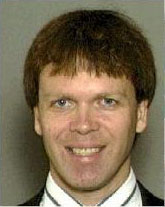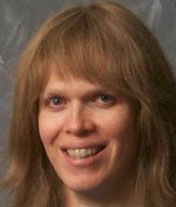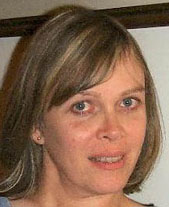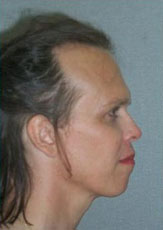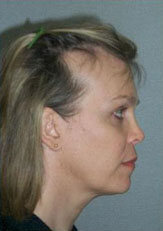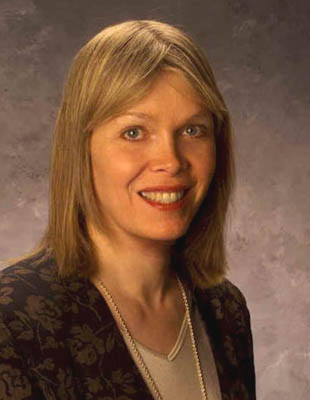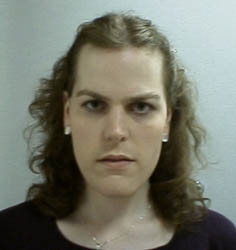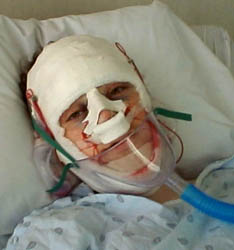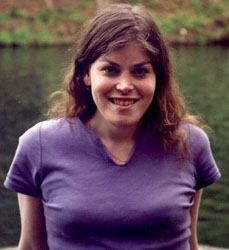-
-
-
-
- La Cirugía de
Feminización Facial (CFF)
- de Lynn
-
- Copyright ©
2000-2010 Lynn Conway
Todos los derechos reservados
- [versión de 10-20-10]
-
(en
inglés)
Traducción por
Sonia John
Redacción por
Araneta
|
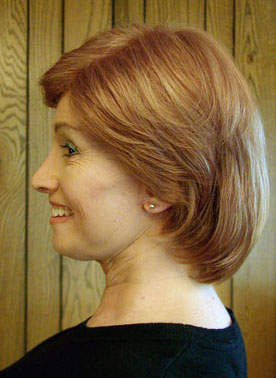
Foto de Lynn
después de la CFF: 29 de marzo de 2000
|
|
|
-
- El 10 de
noviembre de 1999,
Lynn Conway se sometió a la cirugía de feminización facial (CFF). El
Dr. Douglas Ousterhout, M.D., D.D.S. ejecutó esta cirugía de diez horas en
el recinto Davies del Centro Médico California-Pacific en San Francisco. El
Dr. Ousterhout es el cirujano que abrió nuevos caminos en este campo de
cirugía muy agresiva de reconstrucción de los huesos faciales de mujeres
transexuales.
-
- El objetivo
de la cirugia de feminización facial es eliminar o reducir muchos de los
rasgos masculinos de los huesos faciales provocados por los altos niveles de
testosterona presentes durante la etapa pubertal tardía en las transexuales
HaM. Para visualizar lo que ya es posible, lee acerca de las experiencias
quirúrgicas y mira las fotos extraordinarias antes/después en los sitios Web
de Andrea
James, Becky Allison,
Gina,
Madeleine,
Nicki,
Sally y
Rachel, las cuales eran todas pacientes
del Dr. Ousterhout. Ve también
Diane's page about FFS surgery
with Dr. Ousterhout y
La Página FFS del
sitio Web beginninglife.com para más vínculos a fotos y
asuntos acerca de CFF.
-
Ya que aumentaron el número de mujeres transexuales que se sometieron a
este tipo de cirugía durante el inicio de este siglo, las ventajas se
volvieron obvias. Como resultado, surgió la necesidad de que las
cirugías sean más disponibles y respaldadas, lo que expresa Andrea James
en su
mensaje público del 16 de junio de 2006 a la HBIGDA:
"Exhorto que la HBIGDA, tanto como otros consejeros profesionales,
acentúe más en las Normas de Cuidado la importancia del rostro y la voz,
y especialmente sugiero que Uds. aboguen por la necesidad médica de
procedimientos de feminización facial para ellas expuestas a andrógenos
durante la pubertad..."-
Andrea James
-
-
Esta página
proporciona información de fondo, un diario de sucesos y algunas fotos
relativas a la experiencia quirúrgica de la CFF de Lynn, esperando que esta
información le valga a quien contemple tal cirugía.
-
-
-
-
-
-
-
-
-
-
- ALGUNA INFORMACIÓN SOBRE LA
CFF:
A finales de los años ochenta, el Dr. Douglas Ousterhout
llegó a la conclusión que los efectos de masculinización en los rostros de
las transexuales hombre a mujer (HaM) las podían disfigurar y dañar
socialmente tanto como los efectos de deformaciones genéticas en los rostros
de niños, o de los que sufrían las víctimas de accidentes. El Dr.
Ousterhout, que tenía experiencia extensa en cirugía estética, craniofacial,
maxilofacial y reconstructiva, junto con una amplia gama de “trucos”
quirúrgicas que podía utilizar para solucionar tales problemas, abrió nuevos
caminos en la reconstrucción agresiva de los rostros de mujeres
transexuales.
Se describen muchas de las técnicas quirúrgicas de la CFF en
el libro de referencia médica La Escultura Estética de los Contornos del
Esqueleto Craniofacial, por el Dr. Douglas K. Ousterhout, Ed., 1991.
Estas técnicas sobrepasan con mucho la cirugía tradicional estética (como se
puede ver al mirar
los esbozos y
fotos, en el ya mencionado libro, de la supresión de una gran parte de la
frente y de los huesos de las órbitas de los ojos
para eliminar un perfil muy masculino de las cejas).
En el caso de
las mujeres transexuales, el Dr. Ousterhout se centra en modificar las
dimensiones de cada rostro para que se parezcan más a las proporciones
femeninas, basándose en ciertas medidas antropológicas. La necesidad de
supervivencia ha influenciado en la evolución, y esto ha resultado en que
los rostros masculinos se han adaptado para la protección durante la lucha y
la caza y así han desarrollado resaltes de cejas, mentones y mandíbulas
gruesos. Los rostros femeninos (y los de niños), en cambio, han
evolucionado para que las mujeres puedan fugirse y esconderse mejor; les
faltan el resalte de cejas y tienen los ojos más para adelante en la
estructura facial, lo que les proporciona mejor visión periférica. Estas
diferencias de las características secundarias de sexo se desarrollan como
resultado de la presencia de hormonas diferentes de sexo en los cuerpos de
muchachos y muchachas después del comienzo de la pubertad.
-
La influencia de testosterona, la hormona masculina, produce
una masculinización rápida de los rasgos faciales de los muchachos que
comienza durante la pubertad y continúa durante los veinte; también resulta
en la aparición de la barba y el cambio de registro de la voz. La supresión
de la fuente de tesosterona (castración) impide esta masculinización, lo que
se puede ver al mirar
los perfiles
de dos Hijra en el sitio web de Takeshi Ishikawa
(durante muchos siglos muchas transexuales de la India se han sometido como
adolescentes a la castración y la emasculación completa al juntarse a la
casta Hijra; después viven como “mujeres” en “familias” Hijra). A las dos
Hijra en la foto de Ishikawa les faltan grandes resaltes de cejas, tienen
pequeños mentones y mandíbulas, y tienen frentes que se fusionan de manera
suave a la línea de la nariz. Sin la influencia de testosterona, sus rasgos
faciales se quedaron aniñados, y se parecen a los de otras jóvenes
muchachas, aunque por lo general las Hijra no tengan acceso a hormonas
femeninas.
¿Cómo se puede ayudar a las mujeres transexuales obligadas
por las circunstancias a crecer como varones y sufrir la masculinización del
rostro? Se puede llevar a cabo la feminización quirúrgica de rostros
masculinizados por medio de reducir o eliminar el resalte de cejas, de
esculpir la frente, de ajustar el contorno de la nariz, de estrechar y
reducir el tamaño del mentón y de la mandíbula, y de esculpir la tráquea
para eliminar la nuez. Sin embargo, como es el caso en la cirugía
reconstructiva para víctimas de accidentes y niños con fisura del paladar,
esta cirugía es extremadamente agresiva.
-
-
-
Uno no se somete al dolor de una cirugía tan extrema sólo
por “motivos cosméticos.” La paciente debe estar altamente motivada y ser
capaz de aceptar los riesgos reales de soportar dolores y complicaciones.
El período de recuperación posoperativa es doloroso y traumático, y
permanecen secuelas de la cirugía durante mucho tiempo—es común que la
hinchazón de los huesos faciales y el entumecimiento del mentón tarden meses
en reducirse, y que áreas del cuero cabelludo pierdan sensibilidad por un
año o más, o posiblemente permanentemente.
Sin embargo, en algunos casos de transexuales que tengan
resaltes de cejas y mandíbulas muy grandes, se puede decir que la cirugía
CFF es casi la diferencia entre una vida razonable y una muerte en vida, es
decir, entre ser aceptada como una mujer normal o ser puesto en ridículo
público por su apariencia. En muchos casos típicos, la cirugía reemplaza
los rasgos originales del “rostro transexual” por contornos agradablemente
femeninos.
Considera por ejemplo el caso de
Sally,
mostrada en las tres fotos siguientes. La primera foto (a la izquierda) la
muestra todavía como un chico, y un chico bastante guapo. La segunda foto
la muestra después de dos años de tratamiento hormonal y de electrólisis.
Muchas mujeres transexuales se sentirían felices haberse transformado hasta
este punto, y muchas podrían pensar que tienen muy buen aspecto.
Sin embargo, aunque sea sus rasgos se hayan suavizado y sean
algo más femeninos en la segunda foto, se puede percibir que todavía tiene
cierta apariencia de transexual. El contorno de cejas, mentón alto y
mandíbula ancha—que la hacía guapo como un chico—ahora estropean su aspecto
su aspecto de mujer. La tercera foto la muestra después de la CFF ejecutada
por el Dr. Douglas Ousterhout, M.D. Ya percibimos mejor los problemas de la
segunda foto, y por qué ella no parecía linda. La transformación de CFF,
aunque sutil, es realmente profunda. Ya es una mujer de belleza
impresionante, aún sin maquillaje. Este es un resultado excelente, pero no
todos los resultados serán tan impresionantes. Sin embargo, el resultado es
muchas veces vital en términos de autoestima y capacidad de pasar como una
mujer.
-
-
-
Fotos de Sally:
- Antes de la transición/Después de dos años de
hormonas y electrólisis/Después de la CFF por el Dr. Ousterhout
-
-
-
¿Qué ha pasado aquí? ¿Cómo ha cambiado tanto su
apariencia? La solución se descubre al mirar los mismos cambios de PERFIL.
Aunque no nos miramos de perfil casi nunca, así es cómo los demás muchas
veces nos miran. Y es la estructura facial de perfil, y desde ángulos
intermedios, la que más determina la apariencia de nuestros rostros y las
decisiones que hacen los demás acerca de nuestro género. Por eso, es
nuestro perfil el que más frecuentemente nos revela como transexuales e
impide que nos parezcamos hermosas.
Las dos fotos
siguientes muestran el perfil de Sally antes y después de la CFF. Los
cambios son realmente asombrosos. Aunque tenía un aspecto razonable de
frente, su apariencia de perfil antes de la CFF era muy inadequado para una
mujer. Después de la CFF, el contorno de las cejas desapareció, que fue
reemplazado por un contorno redondo típicamente femenino; la nariz fue
esculpido para unirse suavemente con el frente reformado; la altura y el
ángulo del mentón fueron modificados radicalmente; y fue reducida la anchura
de su mandíbula.
-
-
- Retratos de perfil de Sally antes y después de
la CFF:
-
-
-
Son estas retratos de PERFIL los que claramente revelan los
cambios dramáticos de la estructura facial como resultado de la CFF. Estos
cambios de la estructura subyacente de hueso pueden deshacer mucho del daño
causado por la testosterona durante la primera pubertad. Sally finalmente
tiene los rasgos faciales que hubiera tenido si habría experimentado la
pubertad como una chica, con estrógenos en vez de testosterona en su
cuerpo. Los resultados son maravillosos y capaces de cambiar una vida, como
se puede ver en la foto siguiente. Estos resultados indican también qué
importante es que nuestra sociedad ayude a las chicas transexuales temprano
en la vida, para que eviten el desarrollo de rostros tan masculinizados que
sólo pueden ser corregidas más tarde por cirugías tan costosas y dolorosas.
-
-
-
Sally—Ahora una bella mujer
-
-
-
En muchos sentidos la inovación de la CFF está causando un
impacto dramático en las vidas de mujeres transexuales, y en sus
oportunidades de encontrar felicidad, lo mismo que hizo el desarrollo de las
técnicas de la CRS (cirugía de reasignación sexual). La mujer que puede dar
vuelta a la masculinización de su rostro experimenta como resultado algo
mucho más profundo que un ejercicio de vanidad o embellecimiento. Lo más
importante es que estas cirugías muy agresivas se tratan de autoaceptación,
de curarse y de poder finalmente encontrar el lugar cómodo y apropiado
dentro de la sociedad. Para entender más de este proceso, lee el artículo
de
Rebecca Kastl llamado
“Pasar o no pasar”
y luego, lee las palabras de mi amiga
Emily Hobbie:
“Cuando salía de mi casa antes de la cirugía, no importaba
cuanta alegría y paz yo irradiaba—algunos me veía como una persona rara. No
hablo de poder pasar—hablo de cómo, como un ser humano, me veía la gente.
Quiero que la gente me vea claramente, sin mirar por un filtro de dudas para
descifrar quien seré. Por más feliz y optimista como yo fuera antes de la
CFF, las líneas y curvas de mi rostro que no me pertenecían mermaban mi
confianza—eran tan equivocadas como un remolino que se levanta del cuero
cabelludo y que de ningún modo se puede domar.
Estoy segura que, si no hubiera existido la cirugía que
ejecuta el Dr. Ousterhout, yo habría sacado el mejor partido, pero sospecho
que a pesar de toda la felicidad hubiera podido extraer de la vida, la
diferencia entre quien soy y quien decía mi rostro que era me habría
corroído. ¿Quién sabe?
Los resultados aparte, esto no sólo me permite simplemente
movemer por el mundo y por la sociedad—lo mejor que podía esperar en
antemano—sino abrazarla positivamente, encontrar la paz por dentro (o la
posibilidad de esa paz) que los demás ven y perciben. Es un maravilloso
ciclo resonante: el confort relajado que me da mi cuerpo irradia de mí
hacia los demás, quienes a cambio perciben mi equilibrio y vuelven a
reflejar la felicidad hacia mí...”
Al extenderse las noticias de las transformaciones faciales entre la
comunidad transsexual y entre sus psicoterapistas, la clientela del Dr.
Ousterhout aumentó mucho a mediados y a finales de los años 90. Las
noticias se han extendido aún más rápidamente cuando fotos de
“antes/después” comenzaron a aparecer en sitios Web, junto con consejos
acerca de cómo prepararse y hacer frente a una cirugía tan agresiva.
Andrea
James era la primera
mujer transexual que publicó fotos de este tipo en la Web. Estas fotos
animaron a Nicki, Sally, Lynn y muchas otras mujeres transexuales a
visualizar el concepto de CFF y luego también decidirse a someterse a la
cirugía. Hasta mayo de 2001 el Dr. Ousterhout había ejecutado
aproximadamente de 525 a 550 cirugías de reconstrucción facial para
pacientes transexuales.
Muchas mujeres transexuales que planifican una transición ya
se someten a la CFF inmediatamente antes del comienzo de “la prueba de la
vida real.” Esto puede mejorar mucho su aceptación inmediata como mujeres
durante la prueba porque parecen más femeninas después de la CFF. Resalta
que
Andrea,
Becky,
Gina,
Madeleine,
Nicki,
Sally y
Rachel se sometieron a la CFF
con el Dr. Ousterhout estando en las etapas tempranas o intermedias de sus
transiciones sociales.
Una mejor aceptación social durante la prueba de la vida
real posibilita a muchas pacientes que se transicionen socialmente de hombre
a mujer “en el empleo,” asegurándose su fuente de ingresos mientras se
preparan para someterse a la CRS después de la prueba. Aunque la CFF es
bastante costosa, el hecho de evitar le pérdida de empleo puede compensar el
costo de la cirugía. Adicionalmente, ya sabemos que los costos de la CFF se
pueden deducir del ingreso personal al calcular los impuestos, porque la CFF
es una parte del proceso médico global de reasignación sexual y no se la
considera electiva ni cosmética.
El consultorio del Dr. Ousterhout se ubica en el recinto
Davies del Centro Médico California-Pacific. Su dirección es: Dr. Douglas
Ousterhout, M.D., D.D.S., 45 Castro St., Suite 150, San Francisco,
California 94114, USA/EUA, su número de teléfono es (415) 626-2888, y su
correo electrónico es
e-mail link.
Se sugiere que quien desee acordar una cita con el Dr.
Ousterhout llame a su oficina por teléfono y pida hablar con su ayudante,
Mira Coluccio. Para más información acerca del Dr. Ousterhout y sus
técnicas quirúrgicas, ve el sitio
http://www.drdouglasousterhout.com/
-
-
POR QUÉ LYNN SE SOMETIÓ A LA CFF
Lynn, que tiene 55 y tantos años, es una mujer transsexual
post-operada que se sometió a la CRS de hombre a mujer hace bastante tiempo,
en 1968. Ella tuvo la suerte de siempre poder pasar completamente como
mujer, y disfrutó de una carrera y una vida maravillosa como tal.
Sin embargo, Lynn nunca consiguió olvidar los horribles
efectos de masculinización facial que empezaron como adolescente, aunque
tales efectos fueron menos visibles que en los casos de muchas otras
transexuales. La CFF moderna le permitió “revertir el tiempo” y deshacer
una gran parte de los daños físicos de esa experiencia terrible. En
resumen, Lynn se sometió a la CFF para mejorar su experiencia de la vida y
proporcionarse alivio psíquico y felicidad mientras envejece.
La CFF de Lynn incluyó el adelantamiento de la línea del
cabello, el alisamiento de la frente, la eliminación del contorno de las
cejas, la reconstrucción de la nariz, mandíbula y mentón, y la reducción de
la tráquea, todo ejecutado en el curso de una larga cirugía que los
pacientes del Dr. Ousterhout llaman “el todo.” Los resultados son sutiles y
asombrosos a la vez. Lynn todavía “parece Lynn,” especialmente de frente,
pero de perfil ha ocurrido una transformación notable. Lynn ahora se parece
a su hermana, si hubiera tenido alguna.
Lynn espera que la información y experiencias aquí
documentadas ayuden a aquellas que intenten someterse a este tipo de
cirugía. Si la contemplas, o si tienes otras preguntas específicas al
respecto, puedes ponerte en contacto con Lynn por la dirección de correo
electrónico que se encuentra en su Homepage. Lynn también trata de mantener
esta página tan actualizada y útil posible. Si tienes cualquier comentario,
correción o sugerencia, por favor contáctala.
-
Para más información acerca de Lynn, y muchas otras fotos de su vida, ve su
Homepage
http://www.lynnconway.com El sitio siguiente
incluye artículos de prensa acerca de su vida y carrera:
http://ai.eecs.umich.edu/people/conway/Media/Media.html
y se puede leer un retrospectivo detallado
sobre su vida en
http://ai.eecs.umich.edu/people/conway/RetrospectiveT.html
-
-
- LA
DECISIÓN Y LOS PREPARATIVOS:
Simepre me ha gustado estar fuera de casa y a lo largo de
los años he practicado mucho el alpinismo, el paragüismo, el motociclismo,
el backpacking, y el jogging. Mi rostro y cuello, expuestos al sol y al
clima durante tantos años, junto con el proceso natural de envejecimiento,
llegaron a marcar bastantes arrugas en mi rostro y cuello. Al comienzos de
1999 comencé a buscar información sobre cirugía estética para rejuvenecer mi
apariencia.
También busqué en los sitios Web de otras transexuales
información sobre cirugía facial y me encontré con unas fotos asombrosas en
el sitio de Andrea James. Al mirar las fotos antes/después de otras
pacientes, especialmente las de perfil, entendí cuánto influyen los rasgos
del resalte de cejas, la mandíbula y el mentón en la apariencia de género de
transexuales HaM. Además, entendí el concepto de la CFF y vi cuánto había
desarrollado el Dr. Ousterhout estas nuevas técnicas quirúrgicas.
Durante un viaje a California en junio de 1999, consulté al
Dr. Ousterhout para saber cómo me podría ayudar. Como me había dicho Mira,
me hice muchas placas de raios x de mi rostro el día anterior en un
laboratorio en el centro de San Francisco. Luego el Dr. Ousterhout me
examinó y revisó los radiogramas, y discutimos todas las opciones posibles.
Escuché cuidadosamente todas sus recomendaciones iniciales que esbozó sobre
las placas respecto a los cambios que sugería a mi frente, resalte de cejas,
nariz, mandíbula y mentón. Al darme cuenta de la mejora que era posible,
comencé a pensar en serio en hacerlo. Después de regresar a casa,
investigué más poniéndome en contacto por correo electrónico con unas
pacientes anteriores del Dr. Ousterhout para aprender de sus experiencias y
resultados.
A mediados de julio había decidido que realmente necesitaba
hacerme esta cirugía. Necesitaba un lifting de todos modos, y estaba claro
que sería un error hacerla sin hacer antes una reconstrucción de los huesos
faciales, porque si no perdería los efectos del lifting si más tarde me
decidiera a someterme a la CFF.
Me había sometido a varias cirugías a lo largo de los años,
pero era obvio después de haber leído las experiencias de otras pacientes
que la CFF sería un clavario bastante grande comparada con mis experiencias
anteriores. Sería más difícil que la CRS típica. Sin embargo, había
aprendido que la persona que está preparada mentalmente para enfrentarse el
dolor y al trauma, y que no deja que esto le afecte de manera profunda
psicológicamente, acaba por olvidar bastante rápido lo malo. En mi caso, me
parecía que los beneficios compensarían con mucha diferencia los costos.
Volví a visitar el Dr. Ousterhout en agosto de 1999 para una
consulta de planificación detallada. Decidimos que me sometería a “el
todo,” es decir el “pack” completo de cirugías faciales ejecutado de una
sola—y larga--vez. Fijamos la fecha para el diez de noviembre y pagué la
señal. Esto iba a pasar.
Entre agosto y octubre tuve la oportunidad de conocer a
Sally y
Nicki,
dos mujeres que se habían sometido a “el todo” con el Dr. Ousterhout. Me
asombró saber cuánto les había ayudado la cirugía y aprendí mucho de ellas
acerca de la cirugía y el proceso de recuperación. Me dieron además muchos
consejos sobre la preparación, lo que debía llevar conmigo, cosas prácticas
acerca del hospital y su vecindario, y mucha información acerca de lo que
podía esperar durante mi recuperación.
Por ejemplo, por haber hablado con Sally y Nicki y otras
pacientes, y por leer en el internet, comencé a preocuparme acerca de la
claustrofobia de tener que pasar cinco días con relleno dentro de mi nariz.
Para tratar de tranquilizarme, hice una simulación: comí la cena y durmí una
noche entera con una pinza (del tipo que usan los nadadores) fijada en mi
nariz. Era difícil comer y beber, me costaba trabajo tragar, y mis orejas
estallaban todo el tiempo, pero al fin me acostumbré. Claro que iba a ser
un gran fastidio, pero llegaba a pensar que sí podría tolerar el relleno en
mi nariz.
Mientras hacía las maletas para mi viaje y pensaba en qué
llevar conmigo, y planificaba el viaje y el período de recuperación, saqué
mucha información de los sitios Web de otras pacientes. Había muchas
preguntitas que no podía contestar, y muchas otras que no sabía hacer.
Decidí escribir un diario de mis experiencias que podía compartir más tarde.
[Nota: Algunas de las fotos abajo son bastante
sangripesadas. Las incluí para que pacientes potenciales se den cuenta cómo
puedan verse durante la primera etapa de recuperación. Espero que mirarlas
sirva para reducir el choque inicial cuando la paciente se mira por primera
vez en el espejo.
- NOTA IMPORTANTE ACERCA DE LA
PENSIÓN DE RECUPERACIÓN "COCOON HOUSE"
-
- Cuando me liberaron de la unidad de cuidado intensivo del Hospital Davies
dos días después que me sometí a la CFF, tenía varias opciones para alojarme
durante más o menos una semana de recuperación. Había algunos moteles
cercanos (ve
abajo) y los llamados "cuartos de huéspedes" del Hospital
Davies. Estos eran cuartos en un piso del hospital que sobraba en la época.
Costaban $60 por día y allí se podía arreglar que le entregara tres comidas
hospitalarias por día.
-
- Los cuartos eran convenientes y muy cerca al consultorio del Dr.
Ousterhout, pero tenían desventajas--algunas pacientes se sentían muy
aisladas en este piso poco usado. Adicionalmente, no les gustaba a algunas
pacientes la comida hospitalaria. En diciembre de 2000 el hospital comenzó
a usar estos cuartos otra vez y el Dr. Ousterhout finalizó los arreglos para
un nuevo alojamiento para recuperación posoperativa, La Pensión Cocoon, que
ya pertenece a dos enfermeras quirúrgicas del Hospital Davies. Mary-Lou,
una de las dueñas, me envió el email siguiente para anunciar que la pensión
había abierto:
Lynn, me gustaría presentártenos, Mary-Lou y mi compañera Tricia. Somos
enfermeras y trabajamos en la sala de cirugía del Hospital Davies. Cuando nos
enteramos que cerraban los cuartos de huéspedes del hospital, decidimos
convertir nuestros dos apartamientos en una pensión para las pacientes del Dr.
Ousterhout.
Nuestro objetivo es proporcionar un ambiente de apoyo que es seguro, confortable
y libre de tabaco. ¡¡No proporcionamos ningunos servicios de enfermera!! Pero
¡¡nos importan nuestros huéspedes!! Sí proporcionamos comestibles para la gente
que se recupera de la CFF, p.ej. jugos, agua embotellada, Jell-O, pudín, copas
de frutas, sopas y polos. Cada cuarto tiene una telvisión con aparato de vídeo,
estéreo con CD, teléfono (sólo llamadas locales), estufa, refrigerador,
microondas, licuadora, cafetera, secador, y cajas de caudales. Los huéspedes
pueden disfrutar del patio lindo, donde hay un limonero, detrás de la casa. La
pensión se ubica aproximadamente a una milla (1.6 km.) del Hospital Davies. El
transporte público es muy conveniente al costo de $1.00. El vecindario (Valle
de Noe) es culturalmente diverso y conocido por su solidaridad. Desemejante a
la mayoría de esta ciudad, ¡nuestro vecindario es plano! Se puede encontrar
mercados, restaurantes, y casi todos tipos de tiendas y servicios muy cerca a la
casa. Con cariño, Mary-Lou.
A un costo de $125 por día, más o menos, la Pensión Cocoon proporciona
alojamiento ameno, comidas, y acceso fácil a ayuda personal con las necesidades
prácticas durante la recuperación. Esto es realmente un arreglo maravilloso.
Para más información, y para reservar alojamiento antes y/o después de la CFF,
llama a Mira del consultorio del Dr. Ousterhout.
En el diario abajo, cuento mi experiencia que incluyó alojarme en uno de los
cuartos que anteriormente proporcionaba el Hospital Davies. En el futuro ellas
que se sometan a la CFF deben tener en cuenta la diferencia de alojarse en la
Pensión Cocoon (o en un motel) cuando se recuperan después de salir de la unidad
de cuidado intensivo. Se puede leer más acerca de la Pensión Cocoon en
el sitio Web de
la Pensión Cocoon.
LINKS TO FURTHER
FFS INFORMATION:
Since this page was first posted in
2000, ever-increasing numbers of trans women have been undergoing FFS in order
to more smoothly and successfully complete their gender transitions. As a
result, a number of prominent plastic surgeons around the world have begun doing
the type of facial surgery pioneered by Douglas Ousterhout, and are becoming
experienced in these surgeries. More and more women are
posting their stories and photos of FFS results as each year goes by, thus helping other
transitioners better
understand the cost/risk/reward tradeoffs involved in undergoing these
surgeries. All this activity has led to ever-more information about FFS being
posted on the internet. The following links will help you begin to explore all
that information:
Andrea James'
FFS information page, with links to many FFS information resources.
Beginning Life FFS page, with many
links to patients' stories and photos and to prominent FFS surgeons' websites.
Diane's page about her FFS surgery
with Dr. Ousterhout.
European TS information site: This
site provides information on FFS (and SRS) surgeons in many countries (and in
many languages).
Facial Feminization
Information.
Yahoo FFS
Support Group.
Vicki Estrada's photo-diary
video about her Facial Feminization Surgery with Dr. Spiegel in Boston
NEW
Victoria Escher's page about
her FFS with Dr. Ousterhout (including
before/after photos)
NEW
Prominent FFS surgeons' websites:
Douglas Ousterhout, M.D.,
San Francisco, CA
Jeffrey Spiegel, M.D.,
Boston, MA (link to FFS page,
also see many photos at
this link)
Mark L. Zukowski, M.D.,
Chicago, IL
Frans Noorman van der
Dussen, M.D., Antwerp, Belgium
Suporn Watanyusakul, M.D.,
Chonburi, Thailand
Bart van de Ven, M.D., Ghent,
Belgium (procedures,
before/after photos,)
NEW
Marcelo Di Maggio,
M.D., Buenos Aires, Argentina (more,
more,
more,
more,
more,
more)
NEW
-
-
AGREDICIMIENTOS:
Muchas gracias al Dr. Douglas Ousterhout por entender y
preocuparse de los problemas de la desfiguración masculina de los rostros de
mujeres transexuales, y por empeñarse a utilizar su genio creativo y
innovador para solucionarlos, y por emplear su inigualable destreza
quirúrgica para feminizar artísticamente los rostros de tantas mujeres
transexuales.
Gracias también a la jefa del consultorio del Dr. Ousterhout,
Mira
Coluccio, que se tiene una relación muy cercana con todas las pacientes para
ayudarlas a que se preparen y para amenizar sus recuperaciones, y que maneja
el gran consultorio del Dr. Ousterhout para que funcione sin problemas.
Quiero también agradecer a Andrea James,
Sally,
Nicki, Jessica and Carolyn por haberme dado tanta ayuda personal y tanta
enseñanza sobre sitios Web mientras me preparaba para la CFF.
-
-
-
|
El Dr. Douglas Ousterhout, M.D., D.D.S. |
La ayudante del Dr. Ousterhout, Mira
Coluccio |
|

|

|
-
- DIARY OF MY
FFS SURGERY AND RECOVERY:
-
- 11-8-99: I flew to San Francisco one day early to
avoid any possible problems with flight delays. Stayed one night
in the Metro Hotel (see locator maps)
near Davies Hospital. It was beautiful weather today. I enjoyed
a nice walk and scouted all the neighborhoods around the hospital
to locate the Safeway grocery store and drug stores store, the
Muni light-rail-transit stops, and various other services and
restaurants, as useful info for my boyfriend Charlie when he
arrives.Went downtown and had dinner with my friend Rom and her
partner.
-
-
- 11-9-99: Went to Davies Admitting shortly after noon,
and checked into my hospital "Guest Room" where I'll
stay tonite.Checked in with Dr. O's office at 3:00 pm for final
surgical planning, taking of the "before photos", some
lab work, paying of fees, etc. Filled some last minute prescriptions
at a nearby pharmacy on the way to dinner. Then walked over to
have dinner at Chow with Dr. O's recent patient Carolyn, who
had just had the same surgery a month ago. Got some good tips
and hints from her. Called Charlie. Went to bed early.
-
-
- 11-10-99. Surgery Day: Went down to Admitting at 6
am. Signed in and then am wheeled downstairs to prep for surgery.
I'm calm, rested and ready; I guess all those work-outs at the
Y are paying off. My last physical checkup showed BP of 110/60
and pulse of 72. Now a lot begins to happen. It's all very smoothly
efficient, and everything is kind of a blur from here on. The
IV line goes in. I remember being rolled into the operating room,
and talking with Dr. O for a little while. Then, the lights go
out.
-
- The next photo shows me after just awakening the evening
in the ACU after 10 hours on the operating table today. I have
a full face bandage on, and drain tubes are being used to drain
blood and ooze from down within the jaw/chin wound. I'm alert
and don't feel too badly. Of course I realize that this is just
a temporary respite before my body starts reacting to what has
happened to it!
-
-
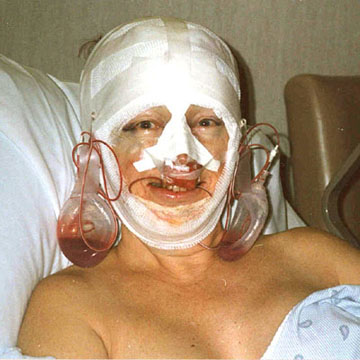
-
-
- 11-11-99: Here I am in the ACU the day after the surgery.
Dr. O has removed the full face bandages. My body has begun to
notice that something extraordinary has happened, and is reacting
accordingly. My face is very swollen now, and I've slowed down
and am settling into grinding my way through the next week or
so.
-
-
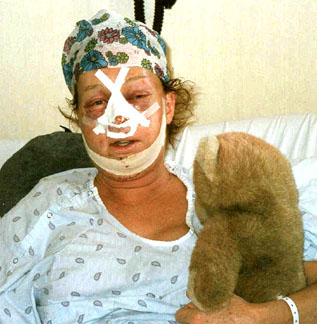
-
- This next photo is late in the afternoon of of the 11th.
My Charlie flew into SF midday, and arrived just after my full-face
bandages had been removed. I was a bit groggy here, but was I
ever so glad to see him and hug him. My face is now very swollen,
but I'm very aware that there are no major problems so far. I'm
not vomiting, my voice sort-of works, my throat isn't sore, I
can see straight and I don't feel particularly weak. Wow, I think
I got lucky - - .
-
-
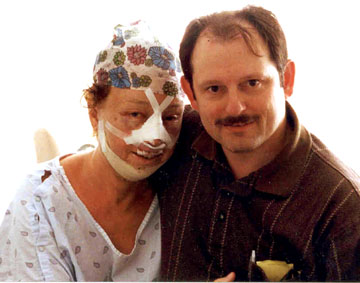
-
- Evening of the 11th. Here I am with my morphine pump
handy. It's keeping me pretty happy. Luckily I have a hearty
appetite, and the pureed food tastes great right now. I'm feeling
awake and am not in much pain now. However, I'm not totally in
contact with reality either.
-
- The facial swelling continues to increase, puffing my cheeks
way out. My hair is a soggy, bloody matted-down mess. Hmm, the
next few days are going to be interesting. Let's get some food
down while the getting's good.
-
-
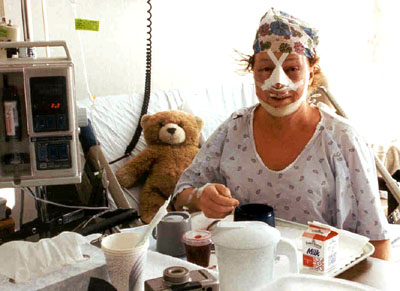
-
- I learned right away that eating was going to be a chore,
because of the nose-packing interfering with swallowing and also
the very limited amount that I could open my mouth.
-
- Then, sometime this afternoon my IV must have backed out
of its vein, because my arm started hurting. I looked at it and
saw that the forearm was all puffed up from fluid being pumped
into it. I realized what was wrong right away and called a nurse,
and she replaced the IV into my other forearm. No harm done,
but I've learned from many past surgeries that it's a good idea
to stay alert for such things, and to buzz for help right away.
-
- I'm also learning lots of wierd things, such as how wonderful
the "suction tube" is. Like the thing at the dentist's
office that sucks spit from your mouth. The problem now is huge
gooey blood clots and ooze up in behind my nose and up into my
sinuses. What makes it worse is every time you swallow anything
with the nose packing in place, some of that wants to go up in
there too! All that aggravates the psychological impact of the
darn nose packing.
-
- At first I tried to snucker that stuff down into the back
of my mouth. It was tough to do, because it was so slimy and
stuck up there. Then I accidently discovered what happened if
I stuck the suction tube back in there and caught the end of
some stuff with it. Wow, it would instantly pull a whole octopus-like
gorpy bunch of it out of there. What relief! Way cool! By the
time I left the ACU on the 12th, I'd half-filled a quart reservoir
with "stuff".
-
- Charlie stayed over at the Metro Hotel on Divisadero tonight,
the 11th. It's just a few blocks away and an easy walk to Davies.
Tomorrow when I move from the ACU into my Guest Room, Charlie
will move in with me too.
-
- The Guest Rooms are on the third floor of Davies, and although
without nursing care they are provided with hospital food services,
and are a short elevator ride and walk from Dr. O's offices.
These rooms provide comfortable, convenient, inexpensive accomodations
once ACU nursing care isn't needed.
-
- [Note: Patients (and partners) would now move to Cocoon
House, the new post-FFS recovery facility that has replaced the
Guest Rooms]
-
- 11-12/13-99: Moved from the ACU into my Guest Room
midday on the 12th. It was great to unpack a bit and get more
of my things within arms reach. What's especially wonderful is
that Charlie can now stay with me all night, sleeping in the
second bed in this room. I encouraged him to play tourist in
SF for 6 to 8 hours each day, so he'd have some fun too. But
having him return each afternoon or evening and spend the night
was wonderful.
-
- Any patient's spouse, S.O., or friend could do the same -
- you can get two keys, and the keyrings are passes through the
Davies Emergency Room area at any time, day or night.
-
- I also met JoAnne, another of Dr. O's patients today. She's
in a guest room just a couple of doors away. We were now able
to keep each other company for a while each day.
-
- The next photo shows Charlie and me in our Guest Room. The
flowers behind my head were sent by my friend Nicki. On the shelf
to the left of Charlie you'll see two "good luck" photos
that I brought with me. One is of Charlie holding one of our
cats. The other is one of my friend Sally bravely showing two
"thumbs up" while in her full-face bandage during her
surgery here.
-
-
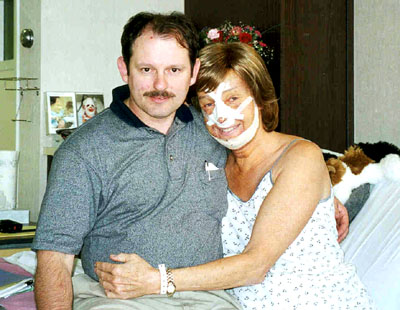
-
-
- 11-14-99: The very worst seems to be over now, and
I've settled into the grind of day-to-day coping with heavy dull
pain. Also, my nights have been pretty fitfull and I haven't
been able to sleep but for a couple of hours at a time. The bruising
on the upper face doesn't look too bad now, and the swelling
now is mainly a problem in the jaw, chin and trach areas. I've
taken on the "chipmunk" look as my friend Sally calls
it. My swollen cheeks make me look like I'm an expressionless
chipmunk with a mouthful of stuff in her cheeks - - .
-
- I've taken to walking around on the 3rd floor (the Guest
Room floor). It's 150 yards around, and is a nice, quiet relaxing
walk. You can circulate for a mile or so without seeing anyone
else, since it's almost unoccupied except for other patients
of Dr. O. You can tell how many are here by looking for food
trays outside the rooms before/after meals.
-
- I almost always left my door open, so I'd see people once
in a while. One of the food servers, undoubtedly new, once brought
my dinner into my room and said "I'm not sure what's going
on on this floor. I bring food up here and leave it outside rooms,
but never see anyone here". I said "This is the Twilight
Zone" in a very solemn voice. That seemed to reassure him
a lot.
-
- It was also very, very comforting to have a number of close
friends visiting me now. My friends Jorge and Susan visited me
yesterday; I'll be staying with them one night before flying
home on the 19th. Today Rom and her partner Luccia visited, as
did my friend Terri Wanke. I've also received lots and lots of
phone calls which, along with the visitors, have really cheered
me up.
-
- I've now begun to get into a very excited state, because
as of today I can see how amazingly this surgery is going to
affect my forehead and browridge. Along with the Vicodin pain
pills, all this has made me extremely hyperactive when on the
phone and with visitors. The nose packing and the associated
breathing and drinking difficulties are a continual nuisance,
but they didn't make me crazy or claustrophobic like I'd worried
they'd do. I'd brought a few Valiums just in case, but didn't
need to use them after all - - - .
-
- Brief description of the overall operation: Dr. Ousterhout
had made a large initial incision that accessed Lynn's forehead
and brow area. This 19 inch incision ran vertically up from the
top of each ear for about four inches, and then horizontally
circled the forward part of Lynn's scalp (the photo below shows
staples reinforcing stitches that hold together a part of this
incision). Pulling this large flap of skin downwards exposed
the forehead and browridge, part of which which Dr. Ousterhout
then sawed out and worked on outside of Lynn's head.
-
- Those forehead and browridge bones were sawed into sections,
and then reassembled with Titanium wires into a flatter form.
Dr. O then ground the surface to a smooth, convex form. After
he reshaped and resized the forehead/browridge, he wired it back
in place using Titanium wires and dissolving screws. For more
details on this unique browridge procedure, see some details
and photos from
Dr. Ousterhout's textbook.
-
- Dr. O then exploited the initial incision to advance Lynn's
hairline: He removed a section of skin and then stretched the
scalp aft of the incision forward to meet the original incision
line. Most of the incision within the hair-covered areas was
reinforced with staples after being stitched.
-
-
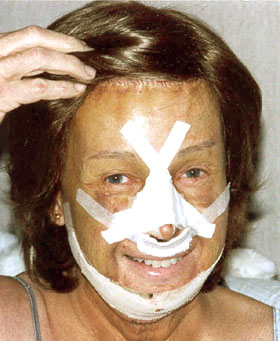
-
- In addition, Dr. O had reshaped my nose, in particular the
bone and cartilage of the nose ridge-line, so that it contoured
nicely into the new brow and forehead contours. He then made
some detailed refinements of the nose tip. In the process, he
straightened out my nose, which had been badly broken years ago
and was quite out-of-alignment left to right. In the photo above,
the nose is shown protected with internal and external splints,
internal packing and an external bandaging.
-
- The jaw and chin area is covered by a bandage compressing
the area where the jawbone has been sectioned both horizontally
and vertically. During the "double-sliding genioplasty",
pieces were taken out of the jawbone to reduce its height and
width and to change the angle of the bone underneath the chin
area. The reduced pieces were then put back together with Titanium
plates, screws and wires. Before reattachment, the jawbone was
then slid forward into a position that will yield a nice, small,
properly-positioned female chin, and then wired into place.
-
- The jaw and chin work is accomplished through a large incision
all around the base of the gums on the inside of the mouth between
the teeth and cheeks. This wound area will be quite painful for
at least two weeks after surgery, and will remain very swollen
for many more weeks after that. It's a nuisance to clean your
teeth after meals, but they have to be kept very clean to avoid
post-op infections. I'm sure glad I brought a child's tooth brush
that could easily slip down into the wound area without stretching
things too much. I think that Mira provides these toothbrushes
to most patients now.
-
- Finally, Dr. Ousterhout opened a small incision up under
my chin, through which he removed sections of tracheal cartilage
to eliminate my "adam's apple". Although mine was a
modest one and hadn't been a problem before, we knew that it
would be visibly quite obvious after my later face-lift surgery.
The trachea reduction area is also bruised and swollen in the
photo, but not too painful, yet. I didn't lose my voice during
early recovery as some have reported, although I had to keep
it rather low and soft to avoid pain from the tracheal wound
area.
-
- Even though my whole face is swollen, bruised and discolored
in the above photo, those who know me can already visualize how
much Dr. Ousterhout set my forehead back and recontoured it to
remove my browridge. Notice the higher eyebrow position, and
how much less my eyes appear to be set back into my face than
in earlier photos of me.
-
-
- Some comments on my surgical recovery so far: I was
very lucky with this surgery: I didn't step on any of the land
mines that some of the other patients have previously encountered
(extended periods of vomiting, severe sore throat from the 10
hours of intubation with a breathing tube, anxiety reaction to
the nose packing and mouth-opening restrictions, double vision
for extended periods, high-fever reaction to the surgery, loss
of voice for extended period, weight loss due to lack of appetite,
extreme tiredness for many days, etc.). Thus my appearance and
attitude returned towards normalcy fairly rapidly.
-
- However, the FFS was a major shock to my system. It was a
real grind to deal with the heavy dull pain from day to day.
You should expect major difficulties in sleeping for the first
few days, and you probably won't sleep all the night through
for the first week to ten days. My bowel movements stopped for
three days (effects of surgery and antibiotics). I'd worried
about constipation, but on the fourth day post-op I had a large
full movement without trouble (probably thanks to taking Metamucil
in some water at my morning meals each day, and a couple of Ex-Lax's
on the 3rd and 4th days).
-
- The basic activities surrounding eating are made quite difficult
due to the effects of the nose packing, the pain and swelling
in your lower gums, and the very limited amount you can open
your mouth ( I could just barely fit my thumb's smaller dimension
between my upper and lower teeth).
-
- For the first four or five days, you'll probably really need
to take a Vicodin pill once every four to six hours. You'll know
when you need to take one. After that, I reduced the dosage to
a half-tablet every six hours and then tailed that dosage off
as the days went by.
-
- Anyone contemplating this serious surgery should prepare
very thoroughly and get in good shape physically. By learning
what to expect day to day from web sites and discussions with
previous patients, one can take things to help cope with possible
problems, and one can also avoid becoming unnecessarily frightened
by and anxious about the ongoing wierd things that occur during
recovery. Visitors and phone calls are good distractions from
the daily grind while in the hospital.
-
-
- 11-15-99: Still spent a very fitfull night. Woke up
in pain, and took a Vicodin. Then got some more sleep. Felt OK
by breakfast. Sort of tired and dazed, but not too bad either.
Stomach a bit upset by a too-full feeling, since still not eliminating
quite enough to keep up with intake.
-
- Finally washed my hair for the first time this morning. Did
this by sitting and leaning back at the sink, using lots of towels,
and care not to get any of the facial bandages wet. Took a long
time even for a crude shampooing to get most of the blood and
goop out, but I felt ever so much better afterwards.
-
- Mira called and said to come to Dr. O's offices at 4pm for
first bandage/stitch removals. Charlie came with me (and watched)
as Mira removed the nose-packing, some of the inside nose stitches,
some of the trachea stiches, and the jaw/chin bandage. Dr. O
came by and he removed my forehead stiches. I'd worried about
pain from some of these procedures, but all were done very quickly
and with only minor, quite tolerable pain. I must say though
that the packing removal procedure was scary, as length after
length kept coming out. I kept wondering when it would end, and
if there would be pain somewhere along the way - - . It turned
out that the anticipation about these procedures, especially
about the removal of the nose-packing removal, was worse than
the reality.
-
- I was feeling well enough by now that Charlie and I decided
to get out of the hospital for a while. We walked from Davies
down to the N-Line Muni light-rail stop just a block away from
the hospital, and took the Muni downtown to the Powell Street
Station. We explored the
San
Francisco Shopping Centre, which you can enter from that
Muni subway station without going outside. It's a neat place
to shop, and you can get there from Davies via the N-Line with
little walking or exposure to the weather (or from Cocoon House
via the J-Line).
-
- We also walked around for a while in the Market Street and
Union Square area, and browsed in some of the department stores
there. I reminisced about the time 31-33 years ago during my
transition when I drove up the Peninsula from Palo Alto each
week to undergo long electrolysis sessions in an office just
off Union Square.
-
- We took the L-line Muni subway back towards Davies, and got
off at Market and Church near the Safeway store. We bought a
bunch of deli goodies at Safeway, and walked back to our room
for a nice evening meal. I had to squash my sandwiches down flat
so that I could fit them into the side of my mouth. But it was
great to be able to eat with the darn nose-packing out!
-
- Slept better that night. Went to bed at 10pm; woke once at
12:30 to go pee; then slept all the way thru to 6:30am the next
morning. Ah that felt nice!
-
-
- 11-16-99:
-
- Felt better after the good nite's rest. Charlie packed, and
we talked a lot. He had to get back to Michigan and his work.
Went down to the lobby at 10am. His "Super-Shuttle"
arrived right on time at 10:30 to get him to the airport plenty
early for his 12:50 flight. I was sad to see him go; he'd been
wonderful through all this, and it had been quite an ordeal for
him too - - .
-
- I got a nice sandwich and some fruit at the corner mart near
Davies. Also checked out the cafeteria down on "B"
level of the hospital, and started bringing tasty items up from
there too, helping to improve my appetite again, which had finally
languished after 5 days on the hospital food.
-
- The rest of that day I spent lots of time on the phone with
friends - - and I called Charlie that eve when he got home -
- our three kitties had been lonely for us, so he gave them hugs
for me too - - .
-
-
- 11-17-99:
-
- Awoke early. Started organizing my stuff a bit, since I'll
be leaving tomorrow. About 9am, Dr. O called and asked if I could
come down early today to have him remove my nose splints (a day
early). I took a Vicodin and went down to his offices.
-
- Dr. O first removed the remaining "X" nose bandages,
and it was then time to remove the internal plastic "splints"
from way back inside of each nostril. I was quite apprehensive,
since I'd read that others had experienced great pain during
this procedure. However, although it seemed like he was pulling
large "bones" from deep inside my face out through
my nose, it didn't hurt all that much. As with the packing, the
anticipation was worse than the event. However, I was sure glad
to get that over with - - - .
-
- Dr. O then handed me a mirror, and I got my first look at
my new face. Albeit with a lot of swelling and bruising still
remaining, I was amazed at how much improvement was already visible.
The new noseridge contoured very gracefully down from the new
female browline to create a wonderful new impression. We chatted
for a while, and he carefully went over various aftercare information:
wash face with fingers (no washcloth) for a while, since the
nose is numb and you want to put even pressure of each side while
the cartilage is still soft; NO EYEGLASSES for six weeks, until
the nose cartilage firms up; no activities that would raise blood
pressure for another two weeks, after which I can resume normal
exercising; no wearing of hats that would put pressure on the
forehead bones for six weeks (bony softness must firm up first);
etc. With all the bandages finally off, I was OK'ed to take a
full shower that day (although the hospital showers are so strong
that I was still very careful not to have it directly spray on
my face and head).
-
- That evening I got really cleaned up and dressed nicely for
the first time since the operation. I put on a skirt and sweater
instead of the khaki's I'd been living in the past week. By now,
my normal make-up covered most of the bruising, and made me look
and feel better too. My friends Dick and Peggy came to visit
me, and we walked over to the Thai House, a few blocks away on
Noe Street for a great Thai dinner and a wonderful evening of
conversation. I was still very swollen and in some pain, but
it was really nice to get out to dinner with my good friends.
-
-
- 11-18-99:
-
- This morning I packed, and then went to Dr. O's offices to
have Mira remove the staples from my scalp, and to have her take
some initial "after" photos. We went over some planning
and logistics for my next trip out for the face-lift on 2-24-00.
-
- Left Davies at 11am; my friend Jorge picked me up; I'll stay
with Jorge and his wife Susan down in San Carlos tonite, and
they'll drive me to the airport tomorrow for my flight home.
-
-
- 11-19-99:
-
- After a nice evening and meal and a good night's sleep at
my friends' place, they drove me to the airport for my flight
home. It was great to get back to Michigan, and see Charlie at
the arrival gate at the airport. The trip was tiring, and I was
so glad to get home, see our kitties again, and to be able to
sleep in our own bed there. Before going to bed I weighed myself.
Amazingly, I still weighed 155#, which was my set-point prior
to deliberately gaining 5# during the two weeks before surgery.
I'd thought that I might lose more weight as, others have reported.
But that didn't happen. Now I need to work a bit to take my set-point
down to 150# , where I've wanted it to be before (and long-term
after) the face-lift surgery in February.
-
-
- 11-24-99 (2 weeks post-op)
-
- My first week home I took it very easy. I was still very
swollen in the jaw/chin area, and in some pain. I also tired
very easily. So it was a time to just relax, eat well, and get
a lot of sleep.
-
-
- 12-1-99 (3 weeks post-op)
-
- Although the swelling hadn't really gone down much, I felt
much better this week. By late in the week I resumed light work
activity, and also resumed moderate workouts at our local Y every
few days.
-
-
- 12-8-99 (4-weeks post-op)
-
- Although everything was healing well, and I was set to return
to normal activities, I hit a problem this week. On Dec. 6th
a small lump appeared at the lower right corner of my chin. By
the 7th it was quite swollen. I called Mira, and Dr. O prescribed
CIPRO.
-
- This localized infection wasn't under control by the10th,
and my face looked a little wierd due to the swollen lump under
the right side of my chin. On the 11th Doug prescribed Augmentin,
a different antibiotic. About 48 hours later the infection eased
and the swelling began to go down. Then late that day, it came
right back again! Doug reassured me that at the worst the local
infection might need to be drained to help the antibiotics work,
and that this minor procedure could be done in Ann Arbor, by
a plastic surgeon at UM Hospital who is a friend and colleague
of his.
-
- The swelling, pain and appearance effects messed up this
week for me. I mostly hunkered-down and stayed at home. So, do
not count on being "fully effective" even this long
after such major surgery. Minor complications can happen. Don't
get your activities too tightly scheduled. Be prepared to deal
with contingencies.
-
-
- 12-15-99 (5-weeks post-op)
-
- During the next week I continued on the Augmentin. Late this
week the swelling eased. Dr. O prescribed some more Augmentin
for me to take for another week, to be completely sure of clearing
the infection.
-
-
- 12-22-99 (6-weeks post-op)
-
- All signs of infection went away this week. I went off the
Augmentin mid-week and finally began to resume all normal activities.
The bony swelling in the jaw and chin is now down quite a bit,
although it is irregular and lumpy in places. Almost all the
bony pain is gone now. My chin was still quite numb, but my lower
lip was more sensitive again so that I didn't "drool"
as much when I eat. I still couldn't open my mouth very wide
(only 20mm), so eating still involved cutting things into small
pieces and inserting things into the side of my mouth.
-
- My appearance when made up, happy and smiling was very nicely
feminine now. Even given the limitations due to healing and recovery,
and how funny and sore my face felt to me, many people at gatherings
felt compelled to comment on "how well I look!" Folks
clearly noticed nice changes, but weren't able to interpret them
and figure out what happened. They're thinking maybe I've lost
weight since they saw me last? Or perhaps I've been doing a lot
of exercising? I also caught glimpses of acquaintances staring
at me in profile in a state of slight confusion. They were probably
trying to figure out why their recollections were so far off-base.
It was fun to experience these reactions, which helped to keep
the smile on too!
-
- 12-29-99 (7 weeks post-op)
-
- The jaw and chin swelling dropped off rapidly this week.
There were still a few random bumps of swelling left, but I'm
finally seeing what the jaw and chin will eventually look like.
It's wonderful! I couldn't be more pleased. The reduction is
far more than I'd originally thought could be done, and the appearance
of the chin is really very cute. Also, the banding and swelling
from the tracheal wound went down a lot, and I could now also
see how much Doug reduced my tracheal "bump". It's
gone completely, and there will be nothing but a nice smooth
neck contour showing once the face-lift is done. Wow, I ever
so thrilled with the results now! I should post some photo updates
sometime soon - - .
-
- 1-10-00 (2 months post-op)
-
- Back to near normalcy now. There is still some lingering
jaw swelling and numbness in my chin and left cheek, and some
"banding" in my neck tissues where the trach incision
was made. The swelling is down enough now to get me worrying
again about needing the face-lift.
-
- 2-10-00 (3 months post-op)
-
- Almost time to go back to Davies for the face lift on Feb.
24th. And it's a good thing: As the FFS swelling went down further,
the need for a face-lift became ever more obvious. A lot of new
wrinkles and sags are showing now, unless I keep a big smile
on my face!
-
- On the other hand, I'm finally able to open my mouth much
wider ( 30mm ), and can thus eat things more normally, including
eating sandwiches without flattening them first!
-
-
-
- LYNN'S INITIAL
FFS SURGICAL RESULTS:
-
- This section provides some photos of and comments on the
results of my FFS surgery as the results become increasingly
evident during longer-term recovery.
-
- First we'll see some initial "after photos" taken
of me on Nov. 26th, when just 2-weeks and 2-days post-op. It's
amazing how fast I'd been healing just the prior few days. I'm
still quite weakened at this point, and have to take it easy.
But, almost all bruising and discoloration have disappeared over
the last couple of days. What's left can be easily covered by
regular make-up.
-
- Of course, there is still very heavy, hard swelling underneath
the jaw and chin, which shows up as large lumps in the following
photos. There is still quite a bit of numbness in the lower lip,
lower jaw and chin, and also in the forehead and brow area. As
the numbness gradually recedes it is replaced by dull heavy pain
and a wierd tinglyness as the nerves begin to recover their functions.
As of this point, I can't yet control my lower lip movements
or my chin's facial muscles, making the effects of the swelling
much more noticeable in person than in photos.
-
- However, I am thrilled at the results we're seeing, even
now at this very early stage with LOTS of swelling and pain remaining
(mainly in the jaw/chin area). My friends will immediately see
the huge difference in my appearance in profile. I've never ever
shown photos of me before in profile, or even front-on photos
without my hair down over my forehead. The elimination of my
old browridge, recontouring of forehead and nose-ridge, and reduction
in size and narrowing of the chin changes all that.
-
- I can't wait to see how it's all going to look when the jaw
and chin swelling goes down completely. Dr. Ousterhout really
performs miracles with his FFS surgeries. Time will tell, but
I think he's done it again - - for me.
-
-
|
Nov. 26, 1999: Lynn at 16
days post-FFS (still with LOTS of
jaw/chin swelling) |
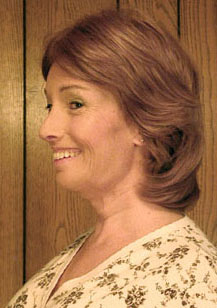 |
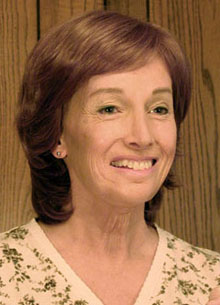 |
-
-
- Also, I noticed a very interesting side-effect of the noseridge
and browridge reduction: My peripheral vision has been greatly
extended up, to the sides, and (in binocular vision) across the
nose, because those bony areas are no longer blocking so much
of the view. It's like shifting from an older car into a newer
one that has a much wider, higher windshield.
-
- As an update, here are some snapshots, including one of Charlie
and me at Christmas dinner while visiting with my brother and
his wife in Wisconsin, and another taken in San Francisco in
February. Even though these photos are limited in resolution,
my new facial contours are quite noticeable in the semi-profile
views taken at 6-1/2 weeks post-op and 3-1/2 months postop:
-
-
|
Charlie and Lynn, December
25, 1999 |
February 22, 2000
|
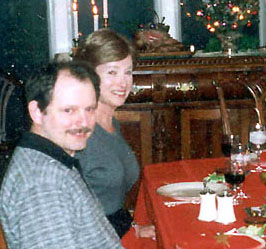 |
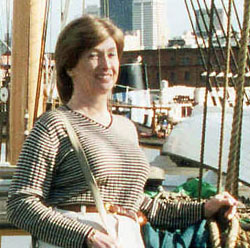 |
-
- Of course, there's still some more to do to complete my FFS
project. It takes several months for the bony swelling to shrink
back to where it's not noticeable. With that shrinkage, all the
bone removal means that I must get a face lift, because at my
age my skin will not shrink back all the way as the swelling
goes away. You can see the loose skin down in the front of my
neck and around my eyes in the detailed 2 weeks + 2 days "after
photos" above. For a while, in late January and February
of '00, I'll actually look lots older because of all that loosened
skin. However, that problem will be solved by Dr. Ousterhout
on Feb. 24, 2000, when he works on me for another 6 hours on
the operating table to do my face-lift and some skin-tightening
around my eyes.
-
-
-
- LYNN'S FACE-LIFT
SURGERY (FLS) DIARY:
-
- In many older patients, face-lift surgery may be necessary
as a follow-up to FFS. Some patients may have already needed
a face-lift prior to FFS, and/or their facial skin may not adequately
shrink and tighten up after the FFS's reduction of facial skeletal
dimensions. In such patients, a face-lift can produce dramatic
overall results, making them not only look more feminine, but
much younger too.
-
- Dr. Ousterhout requires a wait of at least a 3 months after
FFS before doing the face-lift surgery, in order to insure adequate
reduction in bony swelling after FFS. During the final month
or so of that wait, you will not look your best due to all the
wrinkles and sags. By then you'll be highly motivated to get
on with the face-lift!
-
- On February 24, 2000, Lynn underwent face-lift surgery and
blepheroplasty (upper and lower eyelid surgery) by Dr. Ousterhout
at Davies Hospital in San Francisco. For a detailed diary regarding
this surgery, including photos and tips and hints, see the following
subpage:
-
-
-
- The physical impact of face-lift surgery was far less severe
than was FFS. Readers can see the difference for themselves by
comparing the photos of me during early recovery at that face-lift
site, with those of me during early FFS recovery. The first four
days or so after FFS were quite an ordeal. The photos taken during
early FFS recovery show me in great pain, with an extremely swollen
face, grimly hanging on and sweating-out the passage of time.
In contrast, the photos at the Face Lift page show me bouncing
back pretty quickly during early recovery. While there was pain,
bruising and swelling after the face-lift surgery, it was quite
tolerable and nothing in comparison with trauma of the initial
FFS.
-
-
|
Here we go again! Lynn shortly
after face-lift surgery, February 24, 2000 |
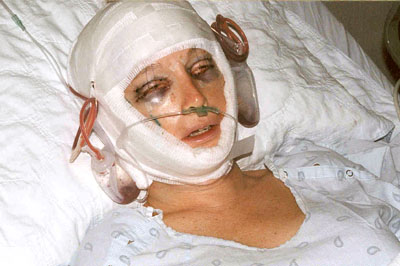 |
-
-
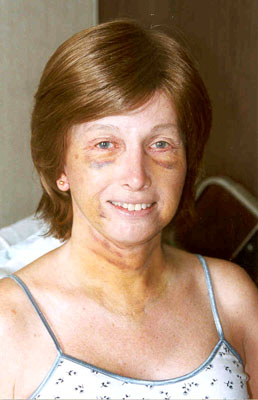 |
Five days after her face-lift
surgery, Lynn is feeling just fine.
February 29, 2000
|
-
- The face-lift and eye-lid surgery put the "frosting
on the cake", and a few weeks later the amazing overall
results of the FFS and FLS surgeries were finally revealed.
-
-
-
- LYNN'S OVERALL
FFS/FLS SURGICAL RESULTS:
-
- Following are digital camera snapshots of my FFS/FLS results,
taken March 29, 2000. My facial skin is still very tight, and
there's still some minor bruising and some swelling remaining
in my cheeks at 5 weeks postop from the face-lift surgery. Although
I'm having a little trouble smiling and making facial expressions,
the overall results of the surgeries are now becoming clear.
-
- I'm very thrilled with these results, which not only make
me look very female but also much younger than my actual age.
The effect of FFS on feminizing my profile seems almost unbelieveable
to me. Then the face lift removed the jowls in my cheeks and
large wrinkles in my face, and also the "turkey neck"
folds of skin under my chin. The blepheroplasty removed the large
bags of skin over and under my eyes. I'll probably undergo laser
resurfacing to reduce the finer facial wrinkles too, but that
will wait for another year or so. Doug has worked his miracle
for me, and it's truly wonderful!
-
-
- March 29, 2000:
Lynn at 4-1/2
months post-op from FFS, and
5 weeks postop from face-lift surgery
- [Lynn's skin is very tight, and she's
having trouble smiling, but the results
look great already]
|
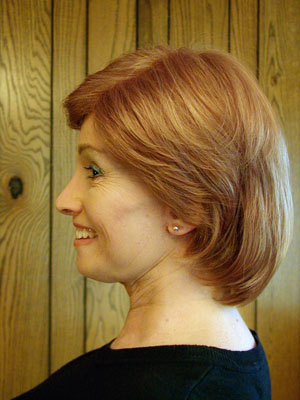 |
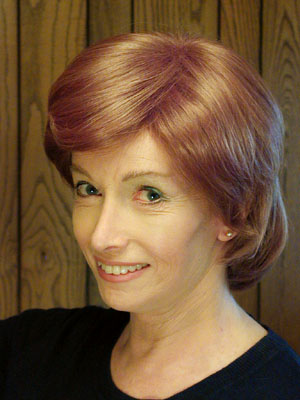 |
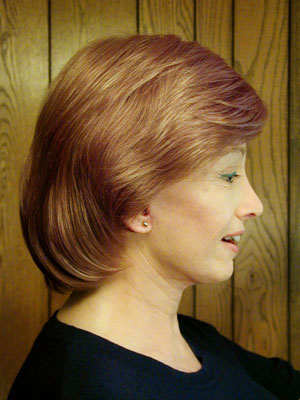 |
-
-
- Following is a photo taken two months later, on May 29, 2000.
My skin isn't so tight now, and I've been getting used to how
my new face "works". I've been exercising my facial
muscles a lot, and I can make more relaxed, natural smiles and
a normal range of nice facial expressions again. Now the result
looks really wonderful to me!
-
-
-
|
September 2000: Lynn after FFS
and FLS (with no make-up on) |
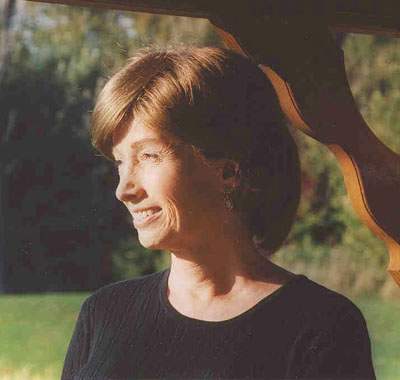 |
-
-
- Note: Lynn enhanced the results of her earlier FFS
and FLS surgeries by undergoing Laser Skin Resurfacing (LSR)
surgery by Jeffrey
Dover, M.D. in Chestnut Hill, MA (near Boston) in early 2002.
This surgery was done to rejuvenate the final appearance of the
facial skin by removing many fine wrinkles, age-spots and other
sun accumulated damage (compare photo above with the one below). The results are subtle but powerful in
"4-D", i.e., when seeing the skin close-up and in motion
(as when speaking and making various expressions). When performed
by a top laser surgeon such as Dr. Dover, LSR surgery can greatly
improve skin tone, not just by removing defects but also by making
the skin much softer, smoother, "plumper" and generally
younger-looking. For additional information about laser skin
resurfacing see:
-
-
